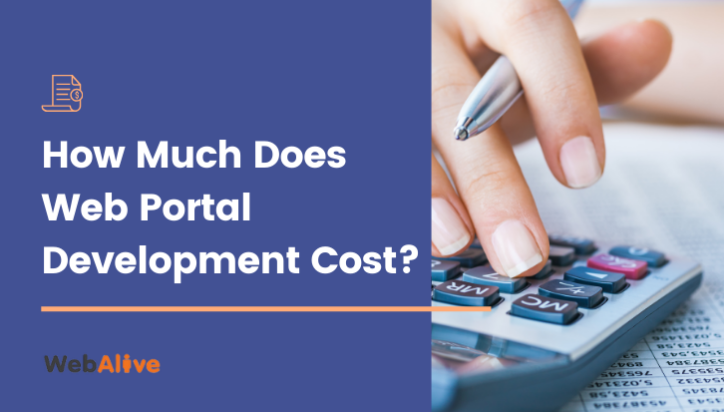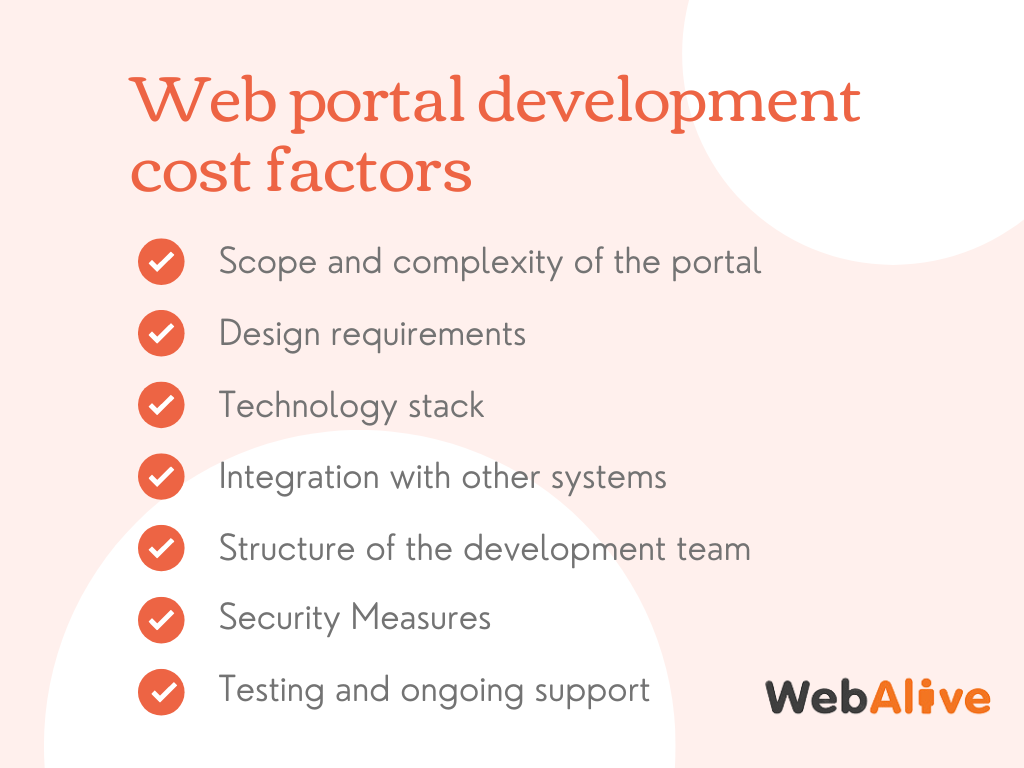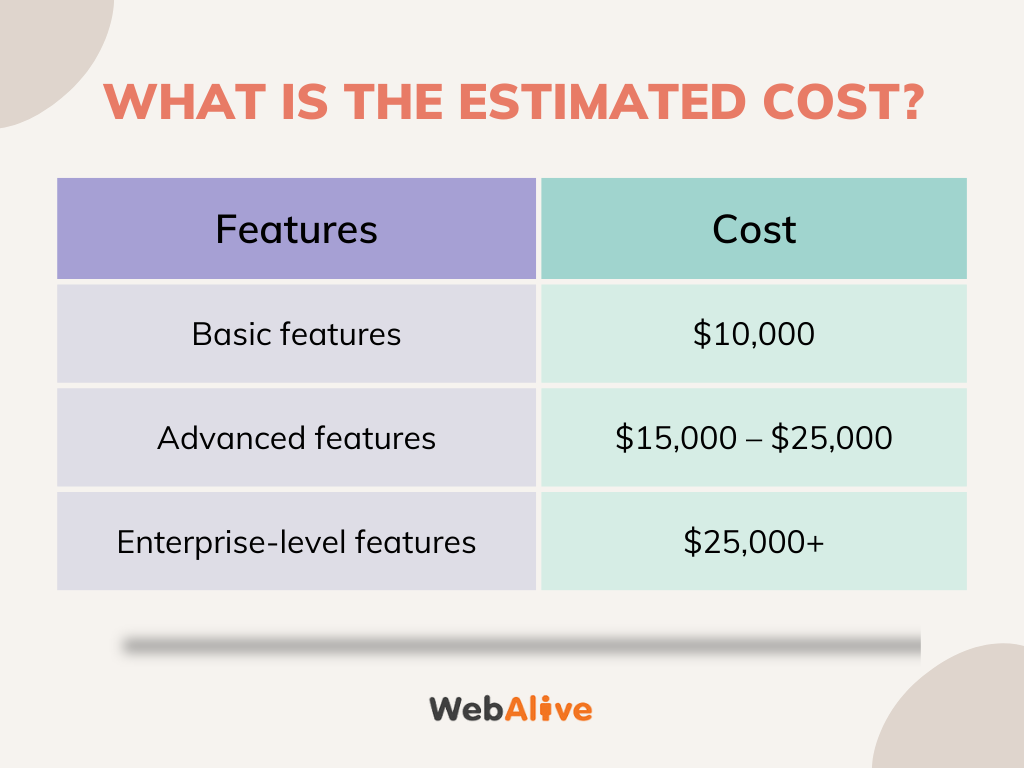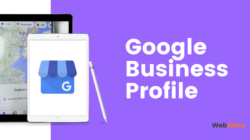
How Much Does Web Portal Development Cost?
As businesses increasingly recognise the pivotal role of web portals, today, the development of a web portal has become not just a choice but a strategic necessity. However, often, people who consider developing a web portal for their business wonder about the total cost of the portal or what influences the ultimate expenses of developing a web portal.
If you’re also contemplating creating a web portal, you are in the right spot. In this quick read, we will outline the associated costs while providing an estimate for a comprehensive portal.
You will discover,
- What is web portal development?
- Factors influencing development costs
- Estimated expenses for a web portal
- Innovative cost-saving ideas for your project
What is web portal development?
Let’s start by establishing a clear definition of a web portal.
A web portal is a specially designed website that plays the role of a single access point for information, resources and services to authorised users- it can be employees, customers, students, partners, etc. It can be accessed through only a particular URL and is only available to authorised users with a unique login.
And the process of designing and developing an interactive web system for specific users is what is known as web portal development. The goal is to provide users with a unified and personalised experience, often incorporating features such as content aggregation, user authentication, collaboration tools, and more.
The difference between a web portal and a website
Navigating the early stages of the web journey, many individuals find themselves confused by the distinction between a website and a web portal. But a web portal is way different from a regular website.
A website consists of web pages that contain publicly available content that can only be changed by the admin. On the other hand, a web portal contains personalised aggregated content which can be changed by authorised users.
In terms of access, a website can be accessible via URL by anyone. But to get access to a web portal, only a specific group of authorised users who have unique login credentials can log in.
7 Factors that influence the cost of web portal development

Developing a web portal is not a one-day task. There are distinct phases that require your time and financial investment to achieve a successful web portal for your business.
1. Scope and complexity of the portal
The cost may vary considerably based on factors such as whether it is a template or a customised design and the level of complexity required. The features incorporated into a web portal largely determine how much time and effort it will take to develop a portal. A simple portal with basic features might include essential functionalities like user registration, content management, and basic search capabilities.
On the other hand, advanced features involve more complex elements such as personalised user dashboards, real-time collaboration tools, real-time communication tools and sophisticated data analytics. A portal with advanced feature requirements will definitely boost the complexity and web portal development cost.
2. Design requirements
Design and User Experience (UX) play a crucial role in influencing the cost of web portal development. Creating a user-friendly interface involves in-depth research and iterative design processes to understand user behaviour and preferences. Extensive usability testing may be required to ensure the interface meets the needs of the target audience, adding to the development timeline and costs.
Also, implementing a responsive design that adapts seamlessly to different devices (desktops, tablets, smartphones) requires additional development effort. And if you incorporate high-quality graphics, images, and multimedia elements, it demands additional design work and may require collaboration with graphic designers and multimedia specialists.
3. Technology stack
When developing a web portal, it’s crucial to choose the right technology stack carefully. Different programming languages come with different development tools and environments. Front-end Development involves user interaction, using HTML/CSS for web structure and style and JavaScript for dynamic interfaces.
On the other hand, back-end Development manages server-side logic and database interactions. Popular languages include Python, PHP, Ruby, and Node.js for scalable network applications. Some tools may be free and open-source, while others may require licensing fees. In addition, some CMS platforms may require licensing fees for commercial use. This cost needs to be factored into the overall budget.
4. Integration with other systems
Many web portals need to seamlessly integrate with existing systems, databases, or third-party services. The complexity of the integrations, such as connecting the portal to customer relationship management (CRM) systems, enterprise resource planning (ERP) solutions, or external APIs, can vary.
And more intricate integrations often require additional development time and expertise. Hence, the cost of development is highly influenced by the level of integration needed and the compatibility of the portal with other systems.
5. Structure of the development team
A skilled development team is essential for constructing robust tools like web portals. It is another cost-defining factor. Consider both the team’s size and skills when putting it together. Including experts in front-end and back-end development, database management, quality assurance, and security can increase project costs. Also, where the team is located matters, as teams from different areas have different rates.
6. Security Measures
Implementing robust security measures involves additional development efforts and costs. Security measures include implementing protocols such as SSL/TLS to encrypt data transmitted between users and the server, or using robust authentication methods (like multi-factor authentication) and defining proper authorisation levels. The complexity of such security features, such as encryption, authentication, and authorisation mechanisms, can influence the overall budget.
7. Testing and ongoing support
Thorough testing, including testing user interfaces, navigation, forms, databases, and any other interactive element, is crucial to ensure that all the features and functionalities of the web portal work as intended.
Performance tests delve into the portal’s responsiveness and scalability, ensuring it can handle varying levels of user activity without compromising on speed or functionality. Simultaneously, security tests are conducted to fortify the portal against potential threats, safeguarding sensitive data and user privacy.
It’s essential to note that the cost of developing such a meticulously tested platform is influenced by the resources and time dedicated to this intricate process. Also, the after-launch activities such as ongoing maintenance, updates and technical support also influence the cost.
So, here we have covered all the possible factors that might impact the estimate of web portal development.
Now, the question is: How much might it cost to develop a website?
What is the estimated cost?

Considering all the mentioned factors, for a portal with basic features and design, the average starting cost is approximately $10,000. The web development cost can vary based on several factors. If you opt to incorporate special custom features, elements, or components into the portal, or if you decide to engage a highly skilled software team for development, the cost may increase.
Considering the anticipated complexity of the website portal, a custom-made advanced portal might cost $15,000 – $25,000, whereas an enterprise-level one will cost $25,000+.
4 Strategies to reduce the cost of developing a web portal
Now, looking for some strategic approaches to ensure development costs are optimised without compromising on quality? Continue your reading.
1. Consider a phased development strategy
Launch the portal with essential features first and gradually introduce additional functionalities to spread out costs over time. This approach will allow your businesses to start generating value from the portal sooner and allocate budgets more effectively.
2. Use open-source technologies
Open-source technologies often come with robust communities, continuous updates, and a wealth of plugins, reducing development time and costs. Outsource a reliable partner to tailor the open-source platform, ensuring a unique and tailored web portal without the hefty price tag of building from scratch.
3. Optimise efficiency with integrations and APIs
Integrating third-party platforms or external services often proves to be a more cost-effective and expedient alternative to constructing features from the ground up. By utilising APIs, engineers can seamlessly link up with these existing systems, enhancing the portal’s functionality without imposing strains on the project’s budget and timeline.
4. Collaborate and communicate
Create transparent communication channels with the development team to prevent any sort of misunderstandings. Regular updates and feedback sessions are vital to keeping the project on course and aligned with business objectives.
Wrapping up
A strong web portal boosts business profitability, competitiveness, and brand loyalty. And measuring the final cost is an important point for any business owner, which you can get by determining website goals, features, recruitment model, and team size to gauge development expense.
So, work closely with a dependable development team, clearly define your scope, and plan your budget carefully.
You read a lot. We like that
Want to take your online business to the next level? Get the tips and insights that matter.

